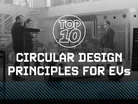Top 10: Circular Design Principles for EVs

Circular Design Principles are transforming the EV industry, challenging the traditional "manufacture, use, scrap" model. Automakers and designers are driving towards a more resilient and sustainable automotive future by rethinking EV development and usage.
The top 10 Circular Design Principles for EVs are:
10 | Design for sustainable battery materials
EV design starts with battery composition. Manufacturers aim to reduce the extraction of finite resources like lithium and cobalt by using recycled or sustainably sourced materials for batteries. This principle prioritises easily recyclable or reusable battery components, contributing to the "technical cycle" of the circular economy in the automotive sector.
9 | Design out emissions and waste
Eliminating emissions and waste is at the heart of EV circular design. Designers create cars with minimal environmental impact by utilising renewable energy in production and focusing on zero-emission vehicles. This principle transforms the traditional automotive industry into a model where materials and energy maintain utility across multiple lifecycles.
8 | Design for battery recyclability
EV design emphasises battery recyclability, ensuring they can be easily disassembled and recycled at the end of their lifecycle. Designers focus on using standardised battery modules and easily separable components. Clear labelling for battery materials and ensuring they can be safely dismantled are crucial for supporting a sustainable, circular EV economy.
7 | Design for multi-purpose functionality
Functionality in EV circular design means creating vehicles that are not only efficient but versatile. It involves designing modular interiors, allowing easy reconfiguration from passenger transport to cargo hauling. By optimising vehicle utility, designers ensure EVs remain valuable for extended periods, reducing waste and resource consumption.
6 | Design for easy maintenance
This principle focuses on making EVs easy to maintain and service, thus extending their lifespan. It includes designing vehicles with accessible components, standardised parts and clear maintenance instructions. By educating EV owners on proper care, the approach fosters a sense of ownership and encourages them to keep their vehicles longer.
5 | Design for repairability
EVs designed for repairability are critical to a circular automotive economy. The principle advocates using modular designs with standardised, interchangeable parts that can be easily accessed and repaired. Providing repair documentation and ensuring the availability of spare parts are essential for promoting resource efficiency and supporting local EV repair economies.
4 | Design for component reuse
Ease of disassembly and reassembly is crucial for EV longevity and parts recycling. Designers employ modular construction and reversible connections for critical components like batteries and electric motors. The design philosophy allows for easy upgrading and component recovery, extending the vehicle's life and simplifying the process of recycling or reusing parts.
3 | Design for standardisation across models
Standardisation involves using common, interchangeable components across different EV models. By employing universal battery formats, charging interfaces and consistent software platforms, EVs become more accessible to maintain, upgrade and recycle. This principle streamlines processes across the EV industry, facilitating more efficient circular economy practices.
2 | Design for circularity of the full EV lifecycle
This holistic approach considers the entire lifecycle of an EV, from raw material sourcing to end-of-life management. It involves sustainable battery production, efficient manufacturing, durable vehicle design and comprehensive recycling programs. Implementing reverse logistics for used EVs and collaborating with stakeholders in circular practices are vital for closing resource loops in the automotive industry.
1 | Design for circular EV business models
At the top of the list is designing for circular EV business models, which reimagines the relationship between cars and consumers. It includes offering EVs as a service through leasing or car-sharing platforms, focusing on battery second-life applications and creating upgradable vehicle systems.
The goal is to decouple automotive economic growth from resource consumption, keeping EVs and their components in use longer, eliminating waste and supporting renewable energy systems.
Make sure you check out the latest edition of EV Magazine and also sign up to our global conference series - Sustainability LIVE 2024.
EV Magazine is a BizClik brand.





